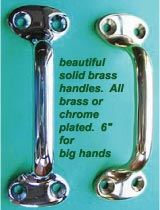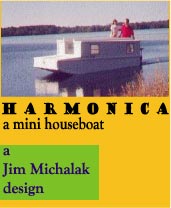Wherever you go in the world, even in extreme environments, you will find that the locals use boats for passenger transportation and/or to move goods. It is fascinating to travel and see the wide variety of boats - as mostly the designs will have evolved to meet the needs of the local environment. This year for our winter holiday we went to Egypt (the one in Africa, not the USA). It was an incredible experience to see life on the River Nile, which in many ways has not changed much for thousands of years, and experience the local forms of river transport.
Our first week was spent on Ra II, a large river boat travelling between Luxor and Aswan, and then back to Luxor, visiting some of the many beautiful temples and tombs on the way. The second week was spent in a hotel in Luxor relaxing and watching the Nile flow past our balcony, with its variety of boats plying their trades. While some boats were industrial, most were tourist boats of various shapes and sizes. The numerous motor boats were of a similar size of about 30’ and held a maximum of about 25 passengers, the feluccas were more variable in size between a small 15’ boat seating 6 to large boats just over 30’ which could take about 20 people.
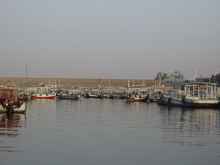 |
Tourist motor boats rafted up waiting for the tourists to return. |
When we stopped in Aswan I took a picture of many motor boats moored, waiting for trade. The situation in Egypt is quite dire for the locals as most work is in the tourist trade. With the recent troubles their trade has almost dried up, leaving them struggling to make a living and what few tourist were there sometimes got hassled by the traders tying to sell goods or provide rides and other services. But despite this we never felt threatened in any way and the traders were always very polite, no matter how persistent they were, when they eventually gave up they would end with ‘have a nice day’ or some equivalent. The news articles on TV and in newspapers always concentrate on any minor disruption and maximise it to sell more papers, (nothing sells papers like scandal or bad news) and are oblivious of the devastating consequences of their actions. Despite what we saw on TV whist there, everyone welcomed us and we never saw any hint of trouble at all. The problems are created by a few dissidents who are not satisfied with the rate of change and the demonstrations are situated only in Cairo around Tahrir Square and the Governors’ Palace. Even there the conflict is further restricted mainly to their weekend (Friday and Saturday) when people have time on their hands and do not have to be earning a living. While we did not visit Cairo, some of our group had, and confirmed that this was the case, and that even a few streets away all was quiet and peaceful apart from the smell of tear gas.
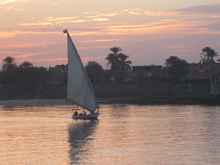 |
An iconic picture for this part of the world, it may have looked exactly the same 2000 years ago |
Having set the scene lets get down to some boat specifics. While there we hade a ride on both a motor boat and a felucca. The motor boats were typical of many small boats run by outboard, but despite the fact that I am building a motor boat it was the sailing boats that caught my eye and imagination.
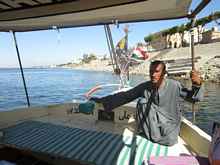 |
Ali handled the boat with practiced ease |
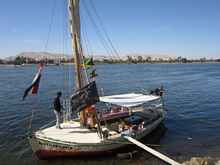 |
Waiting for the next customers. In this case us! |
The man at the helm of our boat, Ali, was a local businessman who owned a motor boat and a felucca and employed a couple of ‘captains’ to help run his business. His English was excellent and we covered many topics of conversation on our three hour trip up the river, with a stop off at a local island to visit a banana plantation, and have a cup of tea. The boat was built on a steel hull, which Ali bought eight years ago and fitted out himself – it transpired that Ali’s family was in boatbuilding so he had the skills required to cut the costs in this way.
At first sight the boat looked rather slow and a bit worn, but with the wind on the beam it was surprisingly speedy. Don’t look for a perfect yacht club finish to the paintwork or the woodwork on any of these boats. This was a working boat, tough, solid and dependable, The paint was cracked in places from the fierce heat (up to 63°C one of the guides told us), the hull was dented from contact with rocks on the bank, and the woodwork was a little rough in some places. But despite all this the craft had an air of grace and elegance.
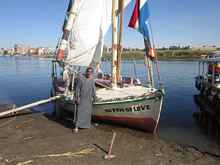 |
Ali with his boat |
The boat, “Queen of Love” was about 28’ long with a beam of 12’ giving it a broad look a little like a melonseed skiff, but with more beam. Despite the width, the draft was only 10” with the centre board up and just a bit over 3’ with the board down. No fancy mechanism here, just brute force and a steel peg to hold the board in position. Ali explained the design was ideal for the local conditions, as it never got too windy and there were no waves to contend with, I doubt it would be very successful on the English Channel with these dimensions.
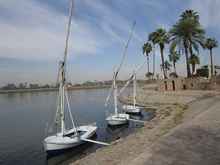 |
Some of the many hundreds of feluccas waiting for customers, these were waiting at our hotel. This picture gives some idea of the overall look of the boat and the different sizes. |
The relatively short mast was made from solid wood, about 8” at the bottom tapering to 6” at the top with the length being about the same as the boat. On both ends there was some metal sheathing to prevent chaff from the boom and gaff. The gaff was held up by a heavy duty halyard and always kept to the starboard side of the mast under the shrouds. Supports for the mast were made from simple galvanised wire, a single forestay, 3 shrouds each side slightly aft of the mast and a further two shrouds about halfway along the boat on the same side as the yard and boom. As you can imagine for a working boat all of the rigging was well worn. On the front of the mast were a number of triangular pieces of wood, located to form a ladder up the mast for access to the rigging. The picture below shows this clearly. You can see how rough the oars are (to the right of the mast).
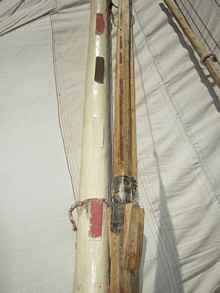 |
The mast with steps painted red, white and black. To the right is a stored oar. |
The gaff was particularly interesting, long and slender, consisting of 4 pieces of wood with 3’ scarf joints and a flag at the top end. The boom was made in a similar manner from two pieces. Unlike most of our boats where the sail is lowered to reef, here the boom is raised up by the topping lift to sit next to the yard. In the full position the lift is eased off to give some ‘body’ to the sail. The main sheet was fastened to a double pulley on a curved piece of metal over the rudder, which acted as a mainsheet traveller – I suspect this was made from rebar with the ridges filed smooth, as the sun shade was also supported by rebar, (I did say it wasn’t sophisticated). At the boom end there were two singe pulleys about 2’ apart, which gave sufficient mechanical advantage to control the 67 m² sail.
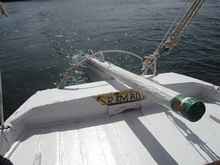 |
Rudder and tiller, tough and utilitarian |
My biggest surprise was the rudder which was about 5’ long and terminated at the bottom edge in a 8” x 8” post just below the surface. This was obviously to prevent damage that may be caused to a thinner or deeper rudder. Despite the fact that it was not very deep it did the job perfectly.
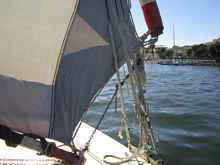 |
This picture gives some idea of the connection between the yard and the boom |
The lateen sail was made of patched strips of thick cotton cloth roped to the gaff at the top and boom at the bottom, these were suspended under the middle shrouds on the starboard side. Leaving the boom rested on the foredeck, to tack the boom was moved to the other side of the foredeck leaving the top end to sweep across the boat to the other side.
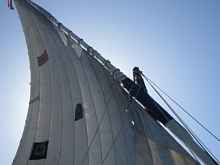 |
Detail at the top of the mast, not sure what to call the ropes going down to the middle bottom of the picture, I suppose it is a boom topping lift. |
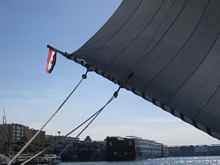 |
Mainsheet connection to the boom was in two single pulleys |
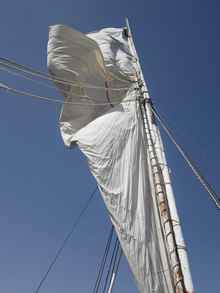 |
Sail reefed with the topping lift drawn tight, this provides some drive downwind. The lateen sail is not designed to be permanently reefed. As the local winds never get too strong it is possible to spill wind by adjusting the trim. |
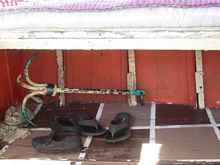 |
Under the starboard seat, an anchor and a good view of the reinforcing ribs of the hull |
Another take on the anchor, I hadn’t seen one quite like this before, obviously designed for use with a rocky bottom. When we stopped the boat was run aground on the sand and roped to a metal spike driven into the sand with a mallet.
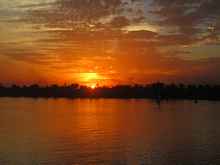 |
Sunsets don’t get much better than this |
Sunsets like this were common, a perfect way to end a days sail.
I usually like to mention companies I receive good service and value for money from, as they deserve to profit from their hard work and commitment. If you want to contact Ali for a sail his boat is moored by the museum in Luxor, mobile Egypt 0106517849.
Click HERE for a list of articles by Mike Machnicki
|



